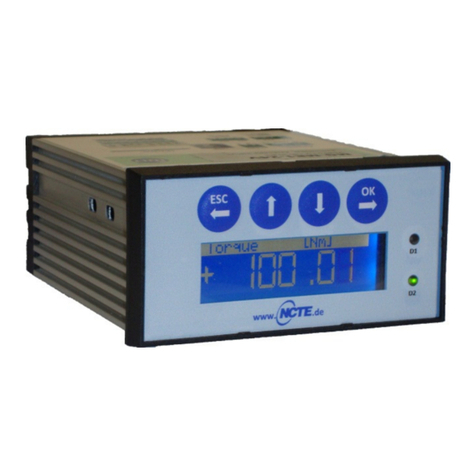
- All data without guarantee, except technical modification -
NCTE torque sensors
Series 2300
Scope of delivery
The torque sensor set consists of the sensor itself (signal pick-up and signal processing integrated into sensor
housing), one connecting cable 5 m with a soldered plug (binder plug no. 99-0426-10-08), key stones (round
shaft) and the calibration certificate.
USB-cable will be delivered in 2,80 m length.
Datasheets and instruction manuals are available at www.ncte.com.
Installation and removal
Make sure to install the sensor shafts exactly with the proper aligned connecting shafts. The key stone
adapter/square endings of the connecting shafts are to be attached forceless to the corresponding ones of
the sensor. No external axial force should be on the housing of the sensor from distortion. A maximum cable
length of 5 m must not to be exceeded. Using a cable or connector other than supplied by NCTE, or a similar
cable that is of a different length may affect the overall performance of the sensor.
Do not remove the shaft with torque applied to the sensor.
Interface description
Mechanical connection:
The key stone adapters on both ends of the measurement shaft are intended for torque transmission.
Electrical connector:
On the sensor housing there is a 8-pin socket for the power supply and the signal output (see chapter
connection plan).
Operation (in regular case or in optimal case)
Optimal measurement parameters can be achieved if the sensor is applied in accordance to the specification.
By compliance with the specification the sensor works generally trouble-free and maintenance-free.
Irregular operation, measures against disturbance
The mechanical overload on the sensor (e. g. exceeding of maximum allowed torque or severe vibrations)
may cause damage to the sensor and in consequence the incorrect signal output. In such cases please do not
open the sensor. Contact NCTE directly for assistance.
Commissioning
After sensor installation pay attention to the following:
Switch on the power supply unit and check the supply voltage. Peak voltage must be avoided! Be
sure to verify the power supply voltage before connecting the sensor!
Connect the sensor to the power supply unit by using the delivered cable.
Connect the sensor output to a high-resistance device such as an A/D converter, oscilloscope, PC
measurement board. The sensor should be in mechanical unloaded state while connecting it.




























